Did you know that there are many different grades of breathing air?
What is Enriched Air?
During the last ten years there has been significant emphasis placed on diving with gas mixtures other than air. As you deep dive in to research, one may begin to ask, “What’s wrong with diving on air?” Air contains two major components, oxygen (21%) and nitrogen (79%).
The nitrogen in normal air (21% O2) limits your bottom time, and the number of dives that can be done in a day, or will require a longer surface interval between dives. Nitrogen is also the cause of decompression sickness.
We welcome in Enriched Air, also called Oxygen Enriched Air, or just Nitrox. Enriched Air is breathing air that has more oxygen in it. Consequently, it has less nitrogen. Since nitrogen is the controlling factor for decompression from no-stop diving, with less nitrogen in the breathing mixture the body will absorb less nitrogen and will have less of a decompression obligation.
The two most commonly used Nitrox mixtures are 32% and 36% oxygen.
So why would I want to use it?
Today’s diver is seeking more adventure and exploration, which almost always leads to the desire for more bottom time. Many times the only way to get that longer bottom time is to plan dives that require lengthy and sometimes complicated decompression stops. Using enriched air (nitrox) makes getting that longer bottom time not only easier by eliminating decompression stops required with air, but this also allows the diver to have shorter surface intervals while still maintaining a minimal level of risk.
By adding additional oxygen to the mixture the rate of nitrogen absorption into the body is reduced thus allowing you to extend your no decompression limits (NDL) beyond those of normal air. Enriched air replaces some of the nitrogen you would breathe underwater with oxygen, so you absorb less nitrogen than you would for the same dive breathing normal air.
Nitrox is of special value when making multi-day, repetitive dives. Dive incident statistics show that almost 80 percent of all cases of decompression illness result from repetitive dives. If a diver instead dove those profiles with an enriched air mixture,
- the decompression illness risk be significantly less,
- there would be an overall reduction of nitrogen in the body,
- as a result of less nitrogen, many divers report that they are not as physically tired after a series of dives with nitrox compared to normal air
If you imagine a typical dive vacation where a diver may be diving two to three times a day for five or six days, it is easy to see that the benefits of using enriched air nitrox become quite significant for either extending bottom time or by reducing required decompression. That is the magic of oxygen enriched air diving.
I’ve heard some things about enriched air, are they true?
With all technology come facts and perceived facts. There are some myths that we need to dispel.
1) “Nitrox is for deep diving.”
Actually, nitrox has very stringent depth limits due to the higher concentration of oxygen in the mixture. The greatest advantages for no-stop diving are in the 50 to 130 feet below sea water (fsw) diving range. The two standard mixtures of EANx 32% and EANx 36% have maximum operational depths of 130 fsw and 110 fsw respectively. There are other applications for using enriched air nitrox to accelerate decompression from deep dives, but these are outside the scope of the primary enriched air training courses. These are covered in other advanced courses.
2) “You can’t get decompression sickness.”
It almost seems obvious that using nitrox provides significant benefits of extending bottom times, but not obvious is its use as an effective tool to help prevent decompression illness. By using a gas with less nitrogen in it we can effectively lower the risk of decompression illness. This does not mean that a diver will never get decompression illness, just that with proper management the already small risk of DCI is even smaller when diving similar profiles using enriched air nitrox.
However no gas nor diving table can absolutely ensure that a diver will not get decompression illness. Using enriched air nitrox provides significant decompression advantages over air, which may help avoid decompression sickness, but with all diving there is a risk of decompression illness.
3) “Narcosis is eliminated.”
It might seem logical that with reduced nitrogen in the breathing mix there would be reduced nitrogen narcosis at depth. The fact is, oxygen can also be a narcotic gas when under pressure. The result is that there is no significant change in narcosis when diving nitrox as compared to air.
Do I need to be trained to use enriched air?
Yes, you will need to complete a PADI Enriched Air course before you can either rent enriched air tanks or obtain enriched air fills.
Click here for more information regarding the PADI Enriched Air specialty course.
EANx / Nitrox and Oxygen Fill Prices
| Item | Price |
| Tanks-A-Lot Fill Card | $50.00 |
| Enriched Air Fill (32% O2) | $12.00 |
| Enriched Air Fill (Custom 22% to 40% O2) | $18.00 |
| Oxygen 0-40 Cubic Feet | $25.00 |
| Oxygen per cubic foot (40 Cuf or More) | $0.65 per cubic foot |
* Tanks-A-Lot Fill Card card may be used for SCUBA Air Fills, Nitrox Fills, or Tank Rentals.
- Standard Air Fill (Up to 3500psi) = 1 Punch
- Enriched Air Fill (22-40% O2) = 2 Punches
- Aluminum Air Tank Rental = 2 Punches
- Aluminum Nitrox Tank Rental = 3 Punches
- Steel Air Tank Rental = 4 Punches
- Steel Nitrox Tank Rental = 5 Punches
This card has no cash redemption value.
